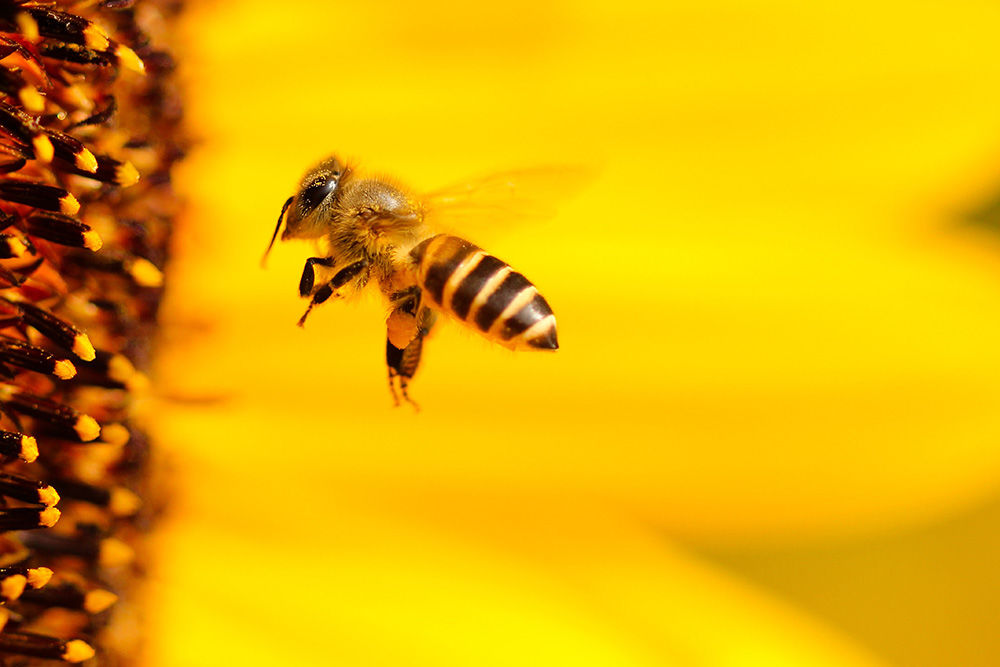Bee-friendly blooms
The best flowers to attract bees to your garden
These days, everyone seems to love a low-maintenance garden full of succulents, cycads, and palm trees. Everyone except bees, that is.
Both introduced honey bees and Australian native bees need flowering plants to survive. They collect nectar from flowers to make honey and gather pollen at the same time, which pollinates the plant as it’s transferred to other flowers. Bees eat honey and some pollen to get them through winter – if they don’t have enough flowers to forage from, they may not make it through.
One of the easiest ways to help native bees and honey bees is by planting flowers in your garden. You don’t have to have a huge garden or beautiful landscaping either – just a range of flowering plants that appeal to bees.
Colour, shape, scent
Bees’ vision is very different from that of humans. They can see colours at the yellow and blue ends of the spectrum most easily, which is why mostly they’re attracted to white, yellow, purple, and blue flowers. They can’t see red, but may still feed on red flowers that have a strong scent.
Honey bees prefer flowers with wide blooms and open petals, so it’s easy for them to reach the nectar inside. However, some native bees have adapted to forage from flowers with deep, bell-shaped blossoms – some have specially extended tongues that can reach into the flower, while others are small enough to fit inside.
Try to plant your flowers in bunches or clumps, so it’s easier for bees to spot them from a distance. Look for types of flower that bloom at different times of the year – bees need food sources from early in spring to late autumn.
Here’s a year of bee-friendly blossoms.
Spring
Lavender
This well-known species flowers from early spring to late autumn. With its distinctive scent, tall purple blooms, and a good supply of nectar and pollen, it’s a natural favourite for native and introduced bees. Lavender is a small to medium shrub that’s generally pretty easy to grow.
Daffodils
With cheerful, bright blossoms in a range of yellows and oranges, daffodils are a sure sign of early spring. Grown from bulbs, they can even bloom late in winter, depending on the climate in your area. Bees are attracted to the colourful flowers.
St John’s Wort – Hypericum
This genus includes around 500 species of flowering plants, from small herb-like plants to larger shrubs. Flowers come in a range of yellows, from pale to vivid. The flowers are wide and flat, with open petals and upright stamens – perfect for nectar collection. Most species bloom from late spring to mid-summer.
Sage – Salvia
The sage we use for cooking is a member of the Salvia genus. Larger ornamental species produce tall purple and blue flowers, which are particularly appealing to Aussie bees. Salvia grows well in hot, dry conditions, needs little maintenance, and can be grown in pots, which makes it appealing for Aussie gardeners as well. Most species of Salvia bloom from mid-spring to mid-summer.
Bottlebrush
Hardy and eye-catching, the bottlebrush makes a handy hedge or screening tree as well as attracting native bee species. Bright red, bristly flowers appear in early spring and last until autumn.
Summer
Sunflowers
Sunflowers are one of the most recognisable flowers around. They produce huge yellow blooms that are made up of thousands of tiny flowers bunched together – providing abundant pollen and nectar for visiting bees. Sunflowers are easy to grow from seed, and bloom throughout summer and into autumn.
Abelia Grandiflora
With masses of white or pink bell-shaped blooms, this shrub attracts native bees in particular – including Blue-banded bees, Teddy Bear bees, and Carpenter bees. It provides plenty of pollen and nectar, and flowers from December to late autumn, making it a valuable resource for native bees.
Cosmos
Cosmos produces large, flat, bright blooms in pink, yellow, orange, and white – exactly what bees like. It’s easy to grow and doesn’t need much in the way of maintenance. Cosmos flowers from summer through to early autumn.
Calendula
A self-seeding annual, calendula has large, multi-layered yellow and orange blooms. It flowers throughout summer and provides a good source of nectar and pollen for native and introduced bees.
Autumn/winter
Daisies
With flat, open flowers, daisies are the perfect shape for nectar and pollen collection – which is why both honeybees and native bees love them. They come in a range of species, including the native Cut Leaf Daisy and Federation Daisy, and the introduced African Daisy. Daisies tend to have long flowering periods, with some – like the Federation Daisy – flowering from autumn to spring.
Borage
The unappealing name belies a very appealing plant. Borage is a small shrub with star-shaped blue-purple flowers that attract both native and introduced bees. It’s also a herb with a long history of medicinal use. Borage blooms in autumn and is easy to grow in pots if you have a smaller garden.
Nasturtium
The nasturtium is a ground-creeper with bright orange or yellow bell-shaped blossoms. It blooms in autumn and attracts honeybees and natives alike. As a bonus, nasturtiums are easy to grow, and the flowers are edible – use them in salads or on cakes to provide a pop of colour.
Support the bees
Planting a bee-friendly, flower-filled garden is a great way to support struggling native bees and honeybees. And you’ll get the benefit of gorgeous flowers blooming throughout the year – it’s a win-win.
Want to know more about planting a bee-friendly garden? Check out our article here.

